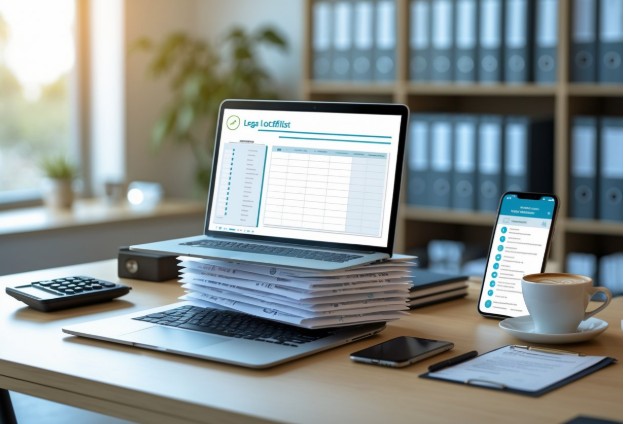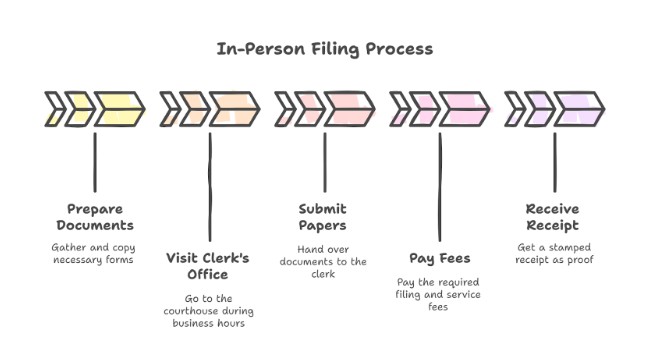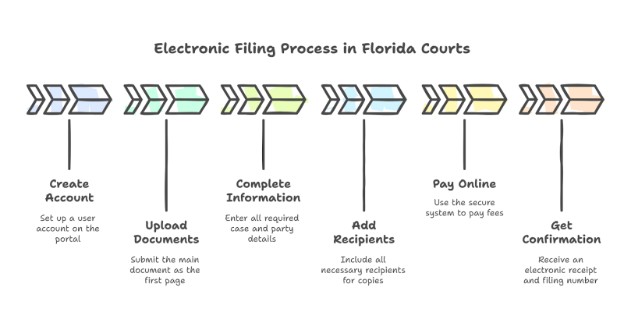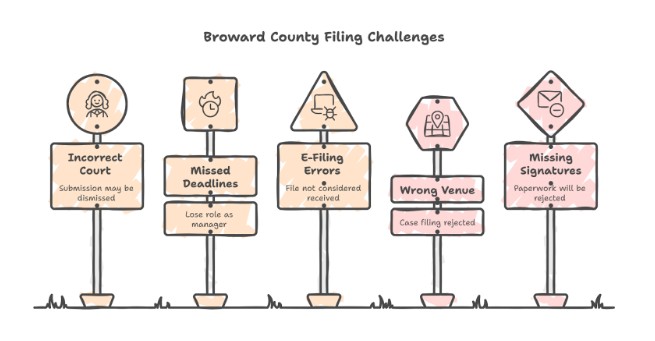Broward County Filing Practicalities: Your Complete Guide to Courthouse Procedures, Fees, and Required Documentation
Originally published: September 2025 | Reviewed by Carol Ann Mazza

To file a family or domestic relations matter in Broward County, bring the required Florida cover sheet (Form 12.928), your initial pleading, and the correct filing fee to the Family Division at the Central Judicial Complex (or the regional courthouse that serves your area).
Filing court documents in Broward County can feel overwhelming, especially if you’re new to the family court system.
Knowing where to file, what fees you’ll face, and which forms you need really makes a difference—sometimes it’s the line between a smooth process and a headache of delays.
The Broward County Clerk of Courts has specific procedures, fees, and documentation that vary depending on the type of family case.
Whether you file in person or use the electronic filing system, getting the details right up front saves you from common mistakes that can drag out your case.
This checklist covers every practical step you need to file family court documents in Broward County. You’ll find tips on selecting the proper courthouse and ensuring you’ve prepared the correct cover sheets.
Key Takeaways
- Family court cases in Broward County must be filed at specific courthouse locations, accompanied by the required fees and proper documentation.
- Both electronic and in-person filings require specific cover sheets and formatting to avoid rejection.
- You can dodge common filing mistakes by following the proper document prep and naming rules.
Who this checklist is for — and when to use it
This checklist is for people and professionals preparing to open or manage a family/divorce matter in Broward County, including:
- Individuals filing a dissolution, family action, or parenting case for the first time.
- Collaborative attorneys, mediators, paralegals, and financial neutrals are preparing client intake packets.
- Self-represented litigants (pro se) who need step-by-step filing guidance and document checklists.
When to use this checklist
- Use this checklist before your first collaborative intake or before filing an initial petition in Broward County.
- Use it when preparing documents for in-person filing or to organize eFiling packets.
- Use it again prior to service of process and at key case milestones (e.g., scheduling conferences, temporary relief hearings).
Quick note: local filing rules and fees change — always confirm current requirements on the Broward Clerk of Court site the week you plan to file.
Where To File A New Family/Divorce Case In Broward County

If you’re starting a new family or divorce case in Broward County, you have to file at the Broward County Courthouse. The main courthouse handles all family law matters for people living in the area.
Primary Filing Location:
- Address: 201 S.E. 6th Street, Ft. Lauderdale, FL 33301
- Phone: (954) 831-6565
The courthouse falls under Florida’s 17th Judicial Circuit. This circuit oversees all family law and divorce cases in Broward County.
What to Bring:
- Completed divorce forms
- Filing fees (amount depends on your case)
- Valid photo ID
- Copies of all documents
File your paperwork with the Clerk of Courts’ office inside the courthouse. The Clerk of Courts handles all family law filings and keeps the official records.
Filing Process:
- Hand in your original documents to the clerk
- Pay the filing fees
- Get your case number and stamped copies
- Set up any required hearings
The courthouse serves the entire population of Broward County, including residents of Fort Lauderdale, Hollywood, Pembroke Pines, and other nearby cities. No other location takes new family law filings.
If you need assistance, you can contact the courthouse by phone or visit during regular business hours. The staff will provide you with basic information to help you navigate the process.
CollaborativeNow Filing Assistance helps Broward filers prepare pleadings, fees, and cover sheets, ensuring a smooth first filing. Contact us to schedule.
If you’re ready to get started, call us now!
Typical Filing Fees You Should Plan For
Filing fees in Broward County change depending on the case. Most fees are set by state law, so they’re generally similar across Florida.
Civil Cases
Civil circuit claims with amounts of $15,000 and above have their own fee schedule. Smaller county civil and small claims cases usually cost less to file.
Family Law Matters
Dissolution of marriage cases cost $408 to file, almost everywhere in Florida. That covers both divorce petitions and responses.
Paternity and adoption cases come with different fees. Each family case type has its own filing fee.
Additional Service Costs
Besides filing fees, you’ll probably need service of process. Service fees are paid to the Broward Sheriff’s Office if the other party resides in Broward.
You pay service costs for each person you serve. They’re not included in your main filing fee.
Payment Methods
The court takes several payment types for filing fees. Credit cards work for most filing fees and background checks.
They also accept cash, checks, and money orders. Always double-check the current fees before filing, as they are subject to change.
Which Cover Sheet To File — Florida Form 12.928 (Cover Sheet For Family Court Cases)
Family court cases in Broward County need Form 12.928 Cover Sheet for Family Court Cases. This form helps the clerk track the court’s workload and statistics.
Who Must File This Form:
- The person starting a new case
- Anyone reopening an old case
The cover sheet goes in with your first pleading. It’s not a substitute for other required documents.
Key Information Required:
- Case style and number
- Type of family law action
- Party information
- Attorney details (if you have one)
The form is a tracking tool for Florida’s judicial workload reporting. Courts use this information to monitor case types and the duration of proceedings.
Filing Requirements:
Hand the cover sheet to the circuit court clerk when you file. The form helps clerks report judicial workload data as required by the state.
You can download the fillable PDF version and fill it out on your computer before filing. The form comes with instructions, so you don’t have to guess.
Everyone—lawyers and people representing themselves—uses the same cover sheet. The clerk relies on this info to assign cases and track statistics.
Documents To Bring For First Filing (Annotated Checklist)
When you file documents in Broward County courts, you’ll need specific paperwork to get your submission processed. The clerk checks for specific items every time you file for the first time.
Essential Documents:
- Original complaint or petition – This starts your case
- Summons – Needed for most civil cases
- Filing fee – Cash, check, or money order to Broward Clerk of Courts
- Valid photo ID – Driver’s license or state ID
Additional Required Items:
- Copies for service – One for each defendant, plus one for yourself
- Self-addressed stamped envelope – For the court to mail back your conformed copies
- Civil cover sheet – Gives the court basic case info
The Broward County Clerk enforces Florida State Statute requirements for all filings. Double-check that you’ve completed and signed all necessary documents.
Important Notes:
- All documents need to be clear and on white paper
- Sign in blue or black ink
- Court rules specify timing requirements for different document types
- Some cases might need extra forms
If you’re filing electronically, you can use the court’s self-service portal for some documents. Still, a few original papers have to go to the courthouse in person.
Try to arrive early in case the clerk spots anything that needs attention or if you need to provide additional paperwork. It’s just less stressful that way.
If you’re ready to get started, call us now!
Step-By-Step Filing Workflow (In-Person And eFiling Options)
Broward County gives you two main ways to file court documents. You can show up at the courthouse or use the electronic filing system—whatever fits your style or schedule.
In-Person Filing Process:

- Prepare Documents – Fill out all necessary forms and make copies. Don’t forget anything—you’ll save yourself a headache.
- Visit Clerk’s Office – Head to the right courthouse during business hours. Sometimes there’s a line, so give yourself extra time.
- Submit Papers – Please hand your documents to the clerk for review.
- Pay Fees – Pay the required filing and service fees. They take cash, checks, or cards.
- Receive Receipt – The clerk will stamp your copies and give you a receipt for proof. Hold onto it—it’s more important than it looks.
Electronic Filing Steps:

The Florida Courts E-Filing Portal makes electronic submission a pretty straightforward process. First, you’ll need to create an account.
- Upload Documents – Make sure the first page is your main document. Don’t bury the lead.
- Complete Information – Enter all the requested case details and party information. Accuracy matters.
- Add Recipients – Decide who else needs to get copies and add them to the list.
- Pay Online – Use the portal’s secure system to pay your fees with a card.
- Get Confirmation – You’ll receive an electronic receipt and a filing number immediately. Save that email or screenshot it, just in case.
Key Differences:
| Method | Hours | Payment | Speed |
| In-Person | Business hours only | Cash, check, card | Same day |
| eFiling | 24/7 availability | Credit/debit card | Immediate |
Both methods require the correct document formatting and accurate fees. Electronic filing is now the standard for most legal documents in Florida courts.
Sample Cover-Sheet Placement And Naming Convention
Cover sheets are the first thing reviewers see. They provide essential case information and help staff direct your documents to the correct locations.
Proper Placement Guidelines
The cover sheet should always be the first page of your filing. Don’t tuck it behind other papers or stick it in the middle somewhere.
If you’re filing electronically, make the cover sheet page one of your PDF. For paper filings, staple it right on top of everything else.
File Naming Best Practices
Digital files require names that actually convey meaning. The file naming convention should look like this:
| Element | Example | Purpose |
| Document Type | CoverSheet | Identifies primary document |
| Case Number | 2025-001234 | Links to specific applications |
| Date | 08252025 | Shows submission date |
| Version | v1 | Tracks document revisions |
Complete Naming Example
CoverSheet_2025-001234_08252025_v1.pdf
Visual Organization Tips
Keep the cover sheet info clear and easy to spot. Don’t stick stamps or sticky notes over essential fields.
Use standard fonts and leave enough space between lines. That way, staff can read what you wrote without squinting.
Color scans usually look better than black and white, but ensure the text remains readable regardless of how you print or scan it.
Common Pitfalls And How To Avoid Them

Filing documents in Broward County isn’t always simple. People often encounter minor mistakes that can slow things down or incur additional costs.
Double-check the correct court before you file anything. If you file in the wrong court, they may thoroughly dismiss your submission. Each case type has its own set of rules.
Missing deadlines can significantly disrupt things. In probate cases, if you don’t file on time, you could lose your role as estate manager.
Electronic filing errors are way too common. The Broward County electronic filing system only accepts documents that go through every step properly. If you don’t complete the process, your file will not be considered received.
Common mistakes to avoid:
- Filing in the wrong venue or court division
- Leaving out required signatures or notarization
- Using old forms from previous cases
- Forgetting to pay the right filing fees
- Sending in copies or scans that are hard to read
Always check jurisdiction requirements for your case type. Divorce, probate, and civil cases all have their own rules and courts.
Review your paperwork carefully before submitting or submitting it. Ensure that names, case numbers, and dates are accurate. Even tiny mistakes can get your filing rejected.
Keep copies of everything you file. The clerk’s office requests originals, but you’ll also want to keep your own records.
Watch formatting rules for electronic submissions. Files must meet size and format requirements; otherwise, the system will not accept them.
Conclusion
Filing documents in Broward County? You’ve got to pay close attention to the rules and quirks of each process. The 17th Judicial Circuit prefers that almost everything be filed electronically, but other records are processed through different county offices.
Key Filing Locations:
- Court documents: Florida Courts eFiling Portal
- Real estate records: Broward County Recording Office
- General court services: Broward County Clerk of Courts
Get your paperwork in order before filing, or you’ll waste time correcting mistakes. You must follow formatting rules, and recording fees vary depending on the document type. State law sets those fees, so there’s not much wiggle room.
Essential Steps:
- Make sure you’ve got the right filing location
- Double-check formatting
- Figure out the fees
- Add any required cover sheets
- Send it in through the right system
The county actually offers some helpful resources if you get stuck. If you have questions about fees or need assistance, please call 954-831-4000 to speak with a staff member.
Electronic systems have made things easier in numerous ways. Still, every document comes with its own set of rules. It’s worth taking a few minutes to learn what’s needed, so you don’t end up redoing the whole thing later.
Finalize your Broward filing with confidence—download the annotated checklist and book tailored filing support by scheduling a review with CollaborativeNow Filing Assistance. Contact us to schedule.
Contact Us Today For An Appointment
Frequently Asked Questions
Where do I file a new family or divorce case in Broward County?
File at the Family Division of the Central Judicial Complex in Fort Lauderdale, or at the regional courthouse that serves your venue; verify location and hours with the Broward Clerk before you go.
What cover sheet do I need to include with my first family pleading?
Include the Florida Cover Sheet for Family Court Cases (Form 12.928) with your initial pleading or motion so the clerk can open the case correctly.
How much will it cost to file my family case in Broward County?
Filing fees vary by case type and change periodically; check the Broward Clerk’s Fees & Costs page the week you file to confirm the exact amount and accepted payment methods.
Can I e-file my family case instead of filing in person?
Yes — Broward Clerk accepts eFilings for many family case types; confirm eFiling eligibility, formatting rules, and user registration on the Clerk’s eServices/eFiling portal.
What should I bring when filing in person?
Bring the signed petition/complaint, Form 12.928 cover sheet, the correct filing fee, proposed summons (and copies for service), and valid ID; bring extra copies for stamping.
How do I avoid common filing rejections or delays?
Avoid rejections by using the correct cover sheet, verifying the venue, paying the exact fee, submitting legible/typed pleadings, and following the Clerk’s eFiling or in-person formatting rules.
What happens after I file — when do I get a case number, and what are the next steps?
The Clerk issues a case number at filing; next steps typically include serving the opposing party, checking local administrative orders, and scheduling any required intake or mediation.
